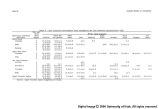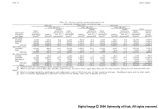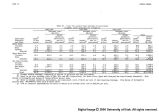| OCR Text |
Show PART IV FUTURE DEMAND Table 29 - Projected concentrations of total dissolved solids in streams with and without a salinity improvement program-Framework Plan '_____________________________fcfi/1) ______________________________________________ Percent change 2000__ 2020________ 1965-2020 Without With Without With Without With Without With Location 1965 program program program program program program program program Colorado River near Cisco, Utah 61i7 730 520 800 1)90 81*0 520 +30 -20 Green River at Green River, Utah 1+65 5'4O 520 690 520 750 560 +61 + 20 Colorado River below con- fluence with Green River 576 660 i|00 770 510 820 550 +1+2 -5 Colorado River above con- fluence with San Juan River 610 700 1*30 830 560 880 600 +I1I4 -2 San Juan River near Bluff, Utah!/ 680 680 960 960 1,300 1,300 +181* +181* Colorado River at Lees Ferry, Arizona 586 700 i*6o 8to 600 920 660 +•=¦" +13 Based on I9AI-66 period of record, considered to be a low average of water supply available in outflow records used in Appendix V. 1/ No effective program on S=m Juan River, as increased salinity occurs below points of use. The program is more economically feasible and effective in Upper Main Stem and Green Rivers, principal sources of salinity. Major causes of salinity increases are the additional stream deple- tions for irrigation, thermal-power production, exports, and the addi- tional salts leached from newly irrigated lands. Considering the com- bined effects of both salt loading and salt concentrating, approximately one-half of the increased water quality degradation will result from in- creased irrigation, as projected by OBERS. A comprehensive discussion of the salinity problem and its relationship to irrigated agriculture in downstream areas is presented in Appendix XV. The water quality effects on downstream areas given above are based on extension of historical trends assuming development with and without a salinity improvement program. The Bureau of Reclamation in cooperation with the Environmental Protection Agency is conducting a research project entitled "Prediction of Mineral Quality of Return Flow Water from Irri- gated Land" which is expected to provide a firmer basis for estimating the water quality effects on downstream areas. The initial study is being conducted in the Vernal Area of Utah. The research project is expected to provide a computer model to predict the salt pickup from various soil pro- files. When the salt pickup from an irrigated area can be predicted and the processes by which salts are dissolved from the soil by return flows are better- understood, drains and irrigation systems can be designed to reduce the volume of the salt pickup from newly developed irrigated lands. The Bureau of Reclamation and the Environmental Protection Agency have completed a cooperative reconnaissance salinity improvement program study of the Upper Colorado River Basin. A report of this study suggest- ing salinity improvement projects for further study is expected to be pub- lished soon. Initial information obtained from this study led to the recent plugging of two abandoned oil test wells in western Colorado which were discharging about 62,500 tons of dissolved solids per year into the Colorado River system. (For more detail regarding salinity improvement and costs, see Appendix XV.) |




































































































































